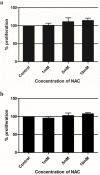Antioxidant Antagonises Chemotherapeutic Drug Effect in Lung Cancer Cell Line A549
- PMID: 32334464
- PMCID: PMC7445980
- DOI: 10.31557/APJCP.2020.21.4.1019
Antioxidant Antagonises Chemotherapeutic Drug Effect in Lung Cancer Cell Line A549
Abstract
Objective: This study aimed to find whether antioxidants increase or decrease the effect of chemotherapeutic drug in the in vitro model.
Methods: Small lung Cancer cell line (A549) was treated with anticancer drug 6-Thioguanine (6-TG) at different concentration viz., 1, 10, 50 and 100μM and the proliferation was measured using MTT assay. The antioxidant N-Acetyl Cysteine (NAC) in different ratios viz., 1mM, 5mM and 10mM were assayed for their effect in proliferation on the A549 cells alone and in combination with 6-TG.
Results: Our experiment proves that anticancer drug 6-TG decreases the proliferation and the antioxidant NAC enhances the proliferation of A549 cells. Strikingly when co-treated with 6-TG, the antioxidant NAC diminished the proliferation reduction action of 6-TG on A549 cells.
Conclusion: Our results suggest that antioxidants in fact benefit the tumor cell growth when treated alone and when in combination with anticancer drug, it severely impair the activity of the drug. We propose that extreme care should be taken when prescribing antioxidants alone or in combination with chemotherapeutics.
Keywords: A549 cell line; Antioxidant; Lung cancer; chemotherapeutic drug.
Figures
References
-
- Alpha-Tocopherol BCCPSG. The effect of vitamin E and beta carotene on the incidence of lung cancer and other cancers in male smokers. N Engl J Med. 1994;330:1029–35. - PubMed
-
- Bracke ME, Depypere HT, Boterberg T, et al. Influence of tangeretin on tamoxifen’s therapeutic benefit in mammary cancer. J Natl Cancer Inst. 1999;91:354–9. - PubMed
-
- Coulthard S, Hogarth L. The thiopurines: an update. Invest New Drugs. 2005;23:523–32. - PubMed
-
- Doroshow JH. Prevention of doxorubicin-induced killing of MCF-7 human breast cancer cells by oxygen radical scavengers and iron chelating agents. Biochem Biophys Res Commun. 1986;135:330–5. - PubMed
MeSH terms
Substances
LinkOut - more resources
Full Text Sources
Medical
Miscellaneous




